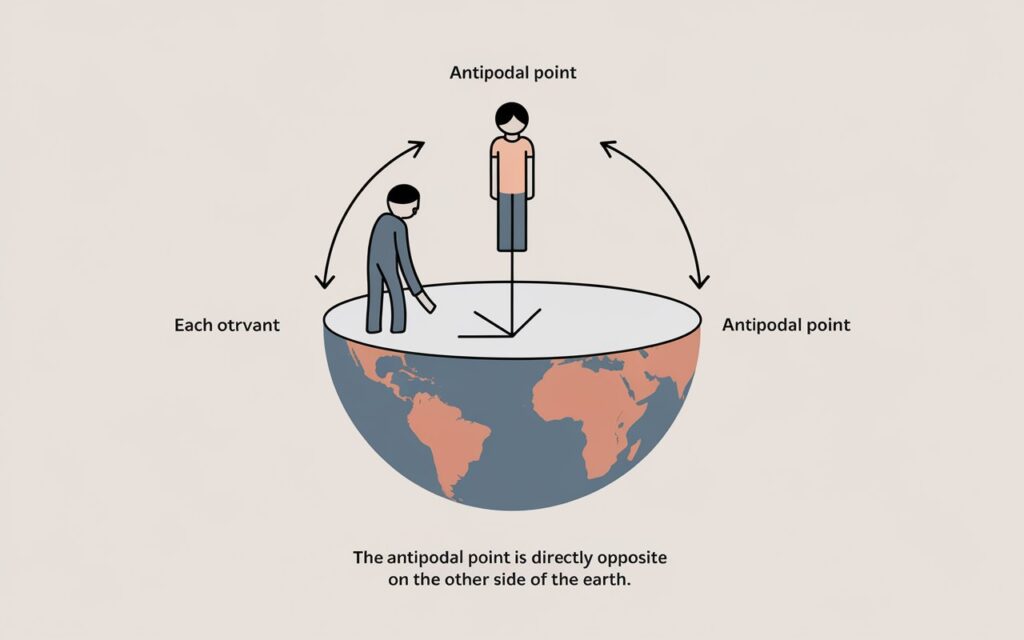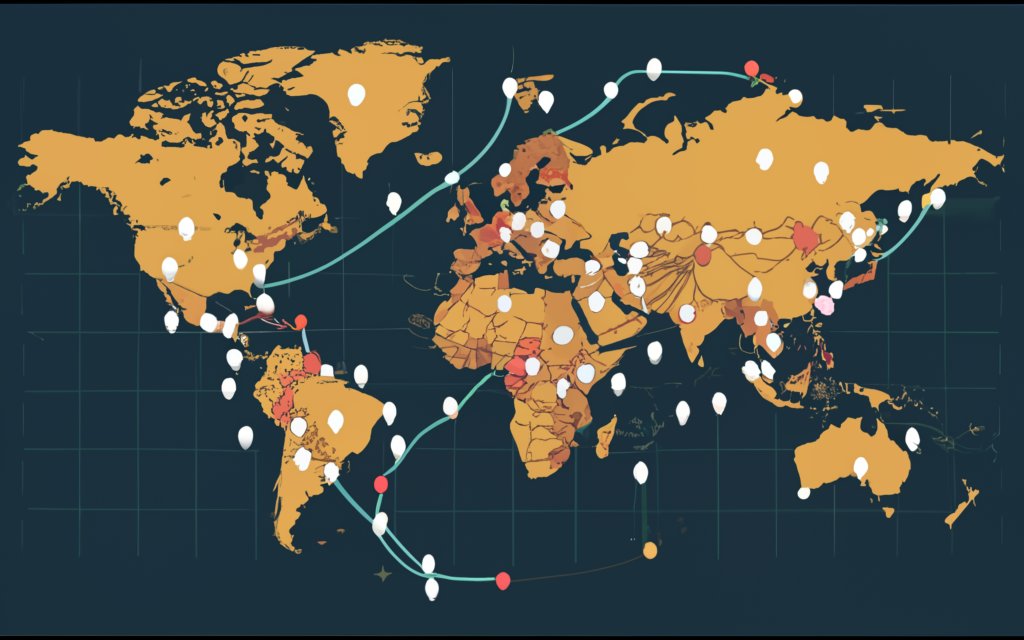
Introduction to Antipodal Points
Have you ever wondered what point on Earth is directly opposite to where you’re standing? If you dig a tunnel straight through the center of the Earth, where would you come out? The answer lies in the concept of antipodal points. This term may sound complex, but it has simple and fascinating implications in fields like geography, physics, geology, and even popular culture. In this article, we’ll explore what an antipodal point is, provide examples, and discuss its significance.
What is an Antipodal Point?
An antipodal point refers to a point on the Earth’s surface that is directly opposite to another point. If you draw a straight line from one point on the surface of a sphere through its center, it would emerge on the other side at its antipodal point. In simpler terms, if you imagine standing at one point on Earth, your antipodal point would be the location on the other side of the globe that is as far away from you as possible.
The Science Behind Antipodal Points
The concept of an antipodal point is based on basic principles of geometry and geography:
- A sphere, like Earth, has two diametrically opposite points. For any point on the surface, there is a corresponding point directly opposite.
- In scientific terms, if a point has coordinates ( x , y , z ) (x, y, z) ( x , y , z ) , its antipodal point would have coordinates ( − x , − y , − z ) (-x, -y, -z) ( − x , − y , − z ) .
This understanding helps in various scientific fields, from studying the Earth’s core to understanding seismic wave propagation.

Examples of Antipodal Points Around the World
Many interesting locations around the world have antipodal points that are either on land or sea. Here are a few notable examples:
- Madrid, Spain — near Wellington, New Zealand.
- Honolulu, Hawaii — near Botswana, Africa.
- Auckland, New Zealand — near Seville, Spain.
- Easter Island, Chile — near Jabalpur, India.
- Ushuaia, Argentina — near a point in Inner Mongolia, China.
Most land locations have antipodal points that fall in the ocean due to the Earth’s land-to-water ratio.
How to Calculate an Antipodal Point
Finding an antipodal point is relatively straightforward with some basic geographical knowledge:
- Latitude: To find the antipodal latitude, simply change the direction (i.e., North to South or vice versa). For example, 40° N becomes 40° S.
- Longitude: To find the antipodal longitude, subtract the original longitude from 180°. For example, if the longitude is 75° W, the antipodal longitude will be 105° E.
Example Calculation:
- Original Point: New York City (40.7° N, 74.0° W)
- Antipodal Point: (40.7° S, 106.0° E), which is in the Indian Ocean.
Geographical Significance of Antipodal Points
Understanding antipodal points is essential in geography and cartography:
- They help illustrate the Earth’s roundness and the distribution of land and water.
- Maps often show antipodal points to indicate the shortest routes for global travel.
- Antipodal points can also provide insights into the Earth’s geophysical properties, such as the distribution of continents and oceans.
Antipodal Points and Earth’s Structure
Antipodal points are also significant in understanding the Earth’s structure:
- Geologists and seismologists study how seismic waves generated by earthquakes travel through the Earth and appear at antipodal points.
- These points provide crucial information on the Earth’s inner core and mantle properties.
Historical Context of Antipodal Points
Historically, the idea of digging a hole through the Earth to reach the opposite side has been a popular thought experiment:
- In medieval Europe, there were myths and misconceptions about reaching the underworld or discovering unknown lands by digging through the Earth.
- Early explorers like Ferdinand Magellan used the concept of antipodal points for global navigation.
Antipodal Points in Popular Culture
Antipodal points have appeared in several movies, books, and media:
- In Jules Verne’s “Journey to the Center of the Earth,” explorers venture toward the Earth’s core, essentially aiming for its antipodal point.
- The concept has also appeared in movies like “The Core,” where characters attempt to restart the Earth’s core by reaching antipodal locations.
Common Misconceptions About Antipodal Points
There are several misconceptions about antipodal points:
- Myth: Digging through the Earth from anywhere will lead to China.
- Fact: Most locations in the Northern Hemisphere are antipodal to ocean points, not land.
- Myth: All antipodal points are on land.
- Fact: The majority of antipodal points on land are actually in the ocean.
How to Use Online Tools to Find Your Antipodal Point
There are many online tools and calculators to find your antipodal point:
- Antipodes Map – Enter your location to instantly find your antipodal point.
- Google Earth – Offers features to visualize antipodal points.
- Online Calculators – Enter latitude and longitude to compute the opposite point.
These tools simplify the process, allowing for fun exploration of Earth’s geography.
Why Antipodal Points Fascinate Scientists and Explorers
Scientists and explorers are intrigued by antipodal points for several reasons:
- They offer insights into Earth’s physical properties and core.
- They provide unique perspectives on global geography and travel.

Antipodal Points and Climate Studies
Antipodal points also play a role in studying climate:
- They can be used to compare weather patterns and climatic conditions at opposite points on the globe.
- Researchers can study ocean currents, wind patterns, and their effects on antipodal locations.
The Role of Antipodal Points in Navigation and Aviation
In modern times, antipodal points have practical applications in navigation:
- They are used in aviation to chart the shortest flight paths, considering Earth’s curvature.
- They help in plotting efficient shipping routes for international trade.
Interesting Facts About Antipodal Points
- About 71% of Earth is covered by water, so most antipodal points fall in oceans.
- There are only a few exact city-to-city antipodal points, like Auckland, New Zealand, and Seville, Spain.
- The concept of antipodal points has been a favorite topic of mathematicians and geographers for centuries.
FAQs About Antipodal Points
What is an antipodal point?
An antipodal point is a point on the Earth’s surface that is directly opposite another point.
How do you calculate an antipodal point?
Reverse the latitude’s direction and subtract the longitude from 180°.
Can an antipodal point be located in water?
Yes, most antipodal points are in oceans due to the Earth’s land-to-water ratio.
Why are antipodal points important?
They are significant in geography, navigation, seismology, and understanding Earth’s physical properties.
Conclusion
Antipodal points are more than just an interesting geographical concept; they hold significance in many scientific fields, from studying the Earth’s core to enhancing global navigation. Whether you’re a geography enthusiast or simply curious about the world, understanding antipodal points provides a unique perspective on our planet.
Important Point
NO. | Important Points |
1. | |
2. | |
3. | |
4. |
See these too
- Read Also: Understanding Biotic Factors: How Living Organisms Shape Ecosystems
- Read Also: Understanding Bedrock: Definition, Composition, and Importance in Geology
